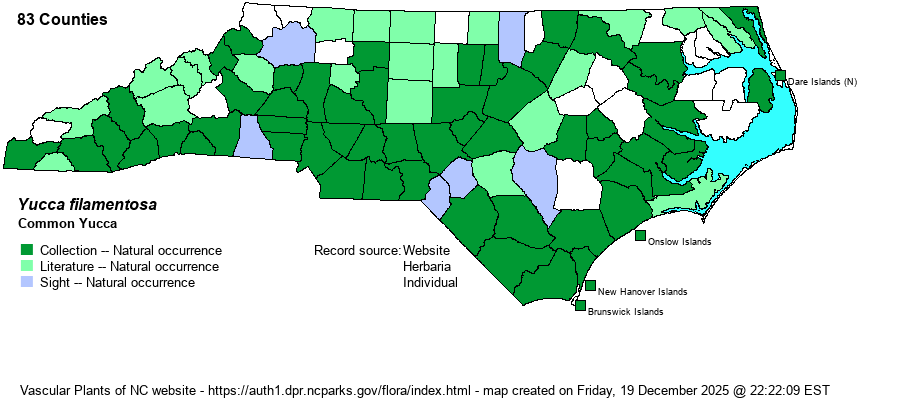| Author | L. | |
| Distribution | Scattered over the entire state, but as it easily escapes from plantings, it is difficult to discern its true native distribution. Seems to be least numerous in the northern Mountains and northwestern Piedmont. However, it has been recorded in nearly every VA county (as a natural occurrence?), and thus it could well occur in all 100 NC counties. The iNaturalist website has numerous county record photos, some certainly refer to planted specimens, but it is literally impossible to know whether specimens or photos refer to natural sites or not. But, as the species has a statewide range in NC and adjacent states to the north and south, most records are included here. This is also a reason for being inclusive of most photos, as the BONAP range map shows an obvious unnatural gap of records from the northern two tiers of NC Piedmont and Mountain counties, with records for nearly every VA county. Note that the very similar Y. flaccida probably has not been ruled out by photo reviewers.
This is a Southern species, ranging north to DE, MD, southern KY, and AR, south to the Gulf Coast of FL to LA.
| |
| Abundance | Fairly common to reasonably common in the southern Coastal Plain and southern Piedmont. Infrequent to locally fairly common in the northern parts of these provinces, except scarce in the northwestern Piedmont (except locally numerous in the Brushy Mountains). Uncommon to infrequent in the southern Mountains, and seemingly rare northward. | |
| Habitat | Native habitats have been obscured by escaped individuals. However, it occurs mainly in thin or open woods, typically where sandy or rocky. In the Piedmont often is found around the margins of granitic flatrocks and granitic domes. It is scarce in moist or rich wooded areas, definitely favoring drier sites, including dunes and maritime forests and edges. In the Sandhills it also favors mesic flats and depressions (Pea Swales) within Longleaf Pine-Wiregrass uplands. |
| Phenology | Blooms in spring, from late April to early June. Fruits in September to October. | |
| Identification | This well-known woody shrub is almost always seen as a basal “rosette” of numerous evergreen leaves, and with a tall stalk of flowers and capsules. The narrowly elliptical leaves, often to about 1-2 feet long, as with other NC yuccas, almost always show “fraying” along the margins; these filamentous threads identify this species from the coastal dune species -– Y. aloifolia and Y. gloriosa. The leaves are somewhat more flexible than those two, as well. The inflorescences are similar -– a long panicle of large, white flowers facing downward. However, the rarer and more poorly known Y. flaccida can be found in the same areas in the southern part of the state as can Y. filamentosa; see that species account for identification notes. | |
| Taxonomic Comments | Formerly, this species was split into several varieties. However, with the recently splitting off of Y. flaccida – named as Y. filamentosa var. smalliana in RAB (1968) -- from Y. filamentosa, most references do not name any varieties for Y. filamentosa now.
| |
| Other Common Name(s) | Adam’s-needle, Yucca, Curlyleaf Yucca, Spoonleaf Yucca, Bear-grass. Adam’s Needle is often the most commonly used common name. However, as this is an idiosyncratic name, and is not helpful as to which yucca species is being named, Common Yucca – as used by NatureServe and a few others – seems to be the best or most helpful common name. | |
| State Rank | S4S5 [S5] | |
| Global Rank | G5 | |
| State Status | | |
| US Status | | |
| USACE-agcp | | |
| USACE-emp | | |

